An Unsaturated/Saturated Coupled Hydrogeological Model for the Llamara Salt Flat, Chile, to Investigate Prosopis tamarugo Survival
Abstract
1. Introduction
2. Study Zone
3. Materials and Methods
3.1. Description of the Unsaturated/Saturated Coupled Hydrogeological Model
3.2. Model Implementation in the Llamara Salt Flat Basin
3.3. Impact of Groundwater Withdrawal and Recharge Rates on Water Table Levels and Soil Moisture Beneath the Tamarugo Trees
4. Results
4.1. Model Calibration and Validation
4.2. Impact of Groundwater Withdrawal and Recharge Rates on Water Table Levels and Soil Moisture Beneath the Tamarugo Trees
4.2.1. Water Table Depth Evolution
4.2.2. Volumetric Water Content Evolution Beneath the Canopy of the Tamarugo Trees
5. Discussion
Author Contributions
Funding
Acknowledgments
Conflicts of Interest
References
- Gaur, M.K.; Squires, V.R. Geographic Extent and Characteristics of the World’s Arid Zones and Their Peoples. In Climate Variability Impacts on Land Use and Livelihoods in Drylands; Gaur, M.K., Squires, V.R., Eds.; Springer International Publishing: Cham, UK, 2018; pp. 3–20. ISBN 978-3-319-56681-8. [Google Scholar]
- Eamus, D.; Zolfaghar, S.; Villalobos-Vega, R.; Cleverly, J.; Huete, A. Groundwater-dependent ecosystems: Recent insights from satellite and field-based studies. Hydrol. Earth Syst. Sci. 2015, 19, 4229–4256. [Google Scholar] [CrossRef]
- Decuyper, M.; Chávez, R.O.; Copini, P.; Sass-Klaassen, U. A multi-scale approach to assess the effect of groundwater extraction on Prosopis tamarugo in the Atacama Desert. J. Arid. Environ. 2016, 131, 25–34. [Google Scholar] [CrossRef]
- Rohde, M.M.; Froend, R.; Howard, J. A Global Synthesis of Managing Groundwater Dependent Ecosystems Under Sustainable Groundwater Policy. Ground Water 2017, 55, 293–301. [Google Scholar] [CrossRef] [PubMed]
- Khair, S.M.; Mushtaq, S.; Reardon-Smith, K.; Ostini, J. Diverse drivers of unsustainable groundwater extraction behaviour operate in an unregulated water scarce region. J. Environ. Manag. 2019, 236, 340–350. [Google Scholar] [CrossRef]
- Viguier, B.; Jourde, H.; Yáñez, G.; Lira, E.S.; Léonardi, V.; Moya, C.E.; Pérez, T.G.; Maringue, J.; Lictevout, E. Multidisciplinary study for the assessment of the geometry, boundaries and preferential recharge zones of an overexploited aquifer in the Atacama Desert (Pampa del Tamarugal, Northern Chile). J. S. Am. Earth Sci. 2018, 86, 366–383. [Google Scholar] [CrossRef]
- Viguier, B.; Daniele, L.; Jourde, H.; Leonardi, V.; Yáñez, G. Changes in the conceptual model of the Pampa del Tamarugal Aquifer: Implications for Central Depression water resources. J. S. Am. Earth Sci. 2019, 94, 102217. [Google Scholar] [CrossRef]
- Viguier, B.; Jourde, H.; Leonardi, V.; Daniele, L.; Batiot-Guilhe, C.; Favreau, G.; De Montety, V. Water table variations in the hyperarid Atacama Desert: Role of the increasing groundwater extraction in the pampa del tamarugal (Northern Chile). J. Arid. Environ. 2019, 168, 9–16. [Google Scholar] [CrossRef]
- Burkart, A. A monograph of the genus prosopis (leguminosae subfam. Mimosoideae). J. Arnold Arbor. 1976, 57, 450–525. [Google Scholar]
- Calderon, G.; Garrido, M.; Acevedo, E. Prosopis tamarugo Phil.: A native tree from the Atacama Desert groundwater table depth thresholds for conservation. Rev. Chil. de Hist. Nat. 2015, 88, 317. [Google Scholar] [CrossRef][Green Version]
- Rojas, R.; Dassargues, A. Groundwater flow modelling of the regional aquifer of the Pampa del Tamarugal, northern Chile. Hydrogeol J 2007, 15, 537–551. [Google Scholar] [CrossRef]
- Sudzuki, F. Absorción foliar a humedad atmosférica en Tamarugo, Prosopis tamarugo Phil. Boletín Técnico Estación Experimental Agronómica Universidad de Chile. Bol. Tec. 1969, 30, 23. [Google Scholar]
- Relaciones Hídricas de Prosopis Tamarugo PhilUso de Isótopos Estables; Acevedo, E., Ortíz, M., Frank, N., Sanguineti, P., Eds.; Universidad de Chile: Santiago, Chile, 2007. [Google Scholar]
- Rojas, R.; Batelaan, O.; Feyen, L.; Dassargues, A. Assessment of conceptual model uncertainty for the regional aquifer Pampa del Tamarugal—North Chile. Hydrol. Earth Syst. Sci. 2010, 14, 171–192. [Google Scholar] [CrossRef]
- SQM Estudio de Impacto Ambiental Pampa Hermosa. 2008. Available online: http://bit.ly/2sATuYH (accessed on 18 December 2019).
- Chávez, R.O.; Clevers, J.G.P.W.; Herold, M.; Acevedo, E.; Ortiz, M. Assessing Water Stress of Desert Tamarugo Trees Using in situ Data and Very High Spatial Resolution Remote Sensing. Remote. Sens. 2013, 5, 5064–5088. [Google Scholar] [CrossRef]
- Novillo, C.J.; Arrogante-Funes, P.; Romero-Calcerrada, R. Recent NDVI Trends in Mainland Spain: Land-Cover and Phytoclimatic-Type Implications. ISPRS Int. J. Geo-Inf. 2019, 8, 43. [Google Scholar] [CrossRef]
- Chávez, R.O.; Clevers, J.; Decuyper, M.; De Bruin, S.; Herold, M. 50 years of water extraction in the Pampa del Tamarugal basin: Can Prosopis tamarugo trees survive in the hyper-arid Atacama Desert (Northern Chile)? J. Arid. Environ. 2016, 124, 292–303. [Google Scholar] [CrossRef]
- Groundwater Recharge in a Desert Environment: The Southwestern United States. Available online: https://www.wiley.com/enus/Groundwater+Recharge+in+a+Desert+Environment%3A+The+Southwestern+United+States-p-9780875903583 (accessed on 18 December 2019).
- Chen, C.; Eamus, D.; Cleverly, J.; Boulain, N.; Cook, P.; Zhang, L.; Cheng, L.; Yu, Q. Modelling vegetation water-use and groundwater recharge as affected by climate variability in an arid-zone Acacia savanna woodland. J. Hydrol. 2014, 519, 1084–1096. [Google Scholar] [CrossRef]
- Kottek, M.; Grieser, J.; Beck, C.; Rudolf, B.; Rubel, F. World Map of the Köppen-Geiger climate classification updated. Meteorol. Z. 2006, 15, 259–263. [Google Scholar] [CrossRef]
- Harbaugh, A.W.; Banta, E.R.; Hill, M.C.; McDonald, M.G. MODFLOW-2000, The U.S. Geological Survey Modular Ground-Water Model—User Guide to Modularization Concepts and the Ground-Water Flow Process; U.S. Geological Survey: Reston, VA, USA, 2000.
- Barlow, P.M.; Harbaugh, A.W. USGS Directions in MODFLOW Development. Ground Water 2006, 44, 771–774. [Google Scholar] [CrossRef]
- Furman, A. Modeling Coupled Surface–Subsurface Flow Processes: A Review. Vadose Zone J. 2008, 7, 741. [Google Scholar] [CrossRef]
- McDonald, M.G.; Harbaugh, A.W. A Modular Three-Dimensional Finite-Difference Ground-Water Flow Model; Open-File Report 83-875; U.S. Geological Survey: Reston, VA, USA, 1988.
- Šimůnek, J.; Van Genuchten, M.T.; Šejna, M. Recent Developments and Applications of the HYDRUS Computer Software Packages. Vadose Zone J. 2016, 15, 15. [Google Scholar] [CrossRef]
- Richards, L.A. Capillary conduction of liquids through porous mediums. Physics 1931, 1, 318. [Google Scholar] [CrossRef]
- Twarakavi, N.K.C.; Šimůnek, J.; Seo, S. Evaluating Interactions between Groundwater and Vadose Zone Using the HYDRUS-Based Flow Package for MODFLOW. Vadose Zone J. 2008, 7, 757–768. [Google Scholar] [CrossRef]
- Van Genuchten, M.T. A Closed-form Equation for Predicting the Hydraulic Conductivity of Unsaturated Soils1. Soil Sci. Soc. Am. J. 1980, 44, 892. [Google Scholar] [CrossRef]
- Mualem, Y. A new model for predicting the hydraulic conductivity of unsaturated porous media. Water Resour. Res. 1976, 12, 513–522. [Google Scholar] [CrossRef]
- Niswonger, R.G.; Prudic, D.E.; Regan, R.S. Documentation of the Unsaturated-Zone Flow (UZF1) Package for modeling Unsaturated Flow Between the Land Surface and the Water Table with MODFLOW-2005; Techniques and Methods 6-A19; U.S. Geological Survey: Reston, VA, USA, 2006.
- Thoms, R.B.; Johnson, R.L.; Healy, R.W. User’s Guide to the Variably Saturated Flow (VSF) Process to MODFLOW; Techniques and Methods 6-A18; U.S. Geological Survey: Reston, VA, USA, 2006; p. 58.
- Bennett, T.H.; Peters, J.C. Continuous Soil Moisture Accounting in the Hydrologic Engineering Center Hydrologic Modeling System (HEC-HMS). In Proceedings of the Joint Conference on Water Resource Engineering and Water Resources Planning and Management 2000, Minneapolis, MN, USA, 30 July–2 August 2000. [Google Scholar]
- Applied Groundwater Modeling-2nd Edition. Available online: https://www.elsevier.com/books/applied-groundwater-modeling/anderson/978-0-08-091638-5 (accessed on 10 October 2019).
- Doherty, J.E.; Hunt, R.J.; Tonkin, M.J. Approaches to highly parameterized inversion: A guide to using PEST for model-parameter and predictive-uncertainty analysis; Scientific Investigations Report 2010-5211; U.S. Geological Survey: Reston, VA, USA, 2010; p. 82.
- Doherty, J. Ground water model calibration using pilot points and regularization. Ground Water 2003, 41, 170–177. [Google Scholar] [CrossRef]
- Bennett, N.D.; Croke, B.F.; Guariso, G.; Guillaume, J.H.; Hamilton, S.H.; Jakeman, A.J.; Marsili-Libelli, S.; Newham, L.T.; Norton, J.P.; Perrin, C.; et al. Characterising performance of environmental models. Environ. Model. Softw. 2013, 40, 1–20. [Google Scholar] [CrossRef]
- Cristi, F.; Fierro, V.; Suárez, F.; Muñoz, J.F.; Hausner, M.B. A TDR-waveform approach to estimate soil water content in electrically conductive soils. Comput. Electron. Agric. 2016, 121, 160–168. [Google Scholar] [CrossRef]
- Doherty, J.; Welter, D. A short exploration of structural noise. Water Resour. Res. 2010, 46. [Google Scholar] [CrossRef]
- Moeck, C.; Molson, J.; Schirmer, M. Pathline Density Distributions in a Null-Space Monte Carlo Approach to Assess Groundwater Pathways. Ground Water 2019. [Google Scholar] [CrossRef]
- Schilling, O.S.; Doherty, J.; Kinzelbach, W.; Wang, H.; Yang, P.; Brunner, P. Using tree ring data as a proxy for transpiration to reduce predictive uncertainty of a model simulating groundwater–surface water–vegetation interactions. J. Hydrol. 2014, 519, 2258–2271. [Google Scholar] [CrossRef]
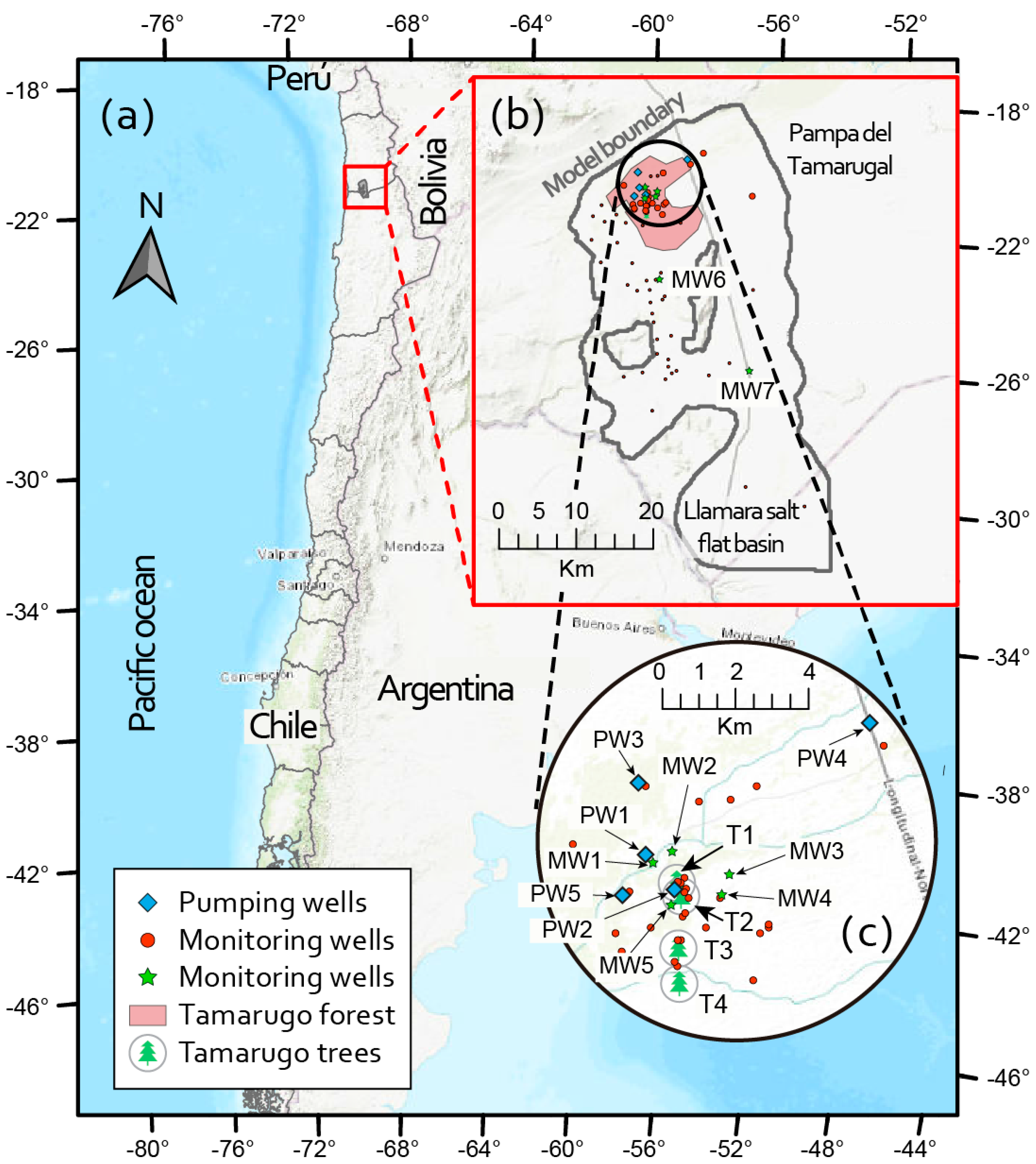
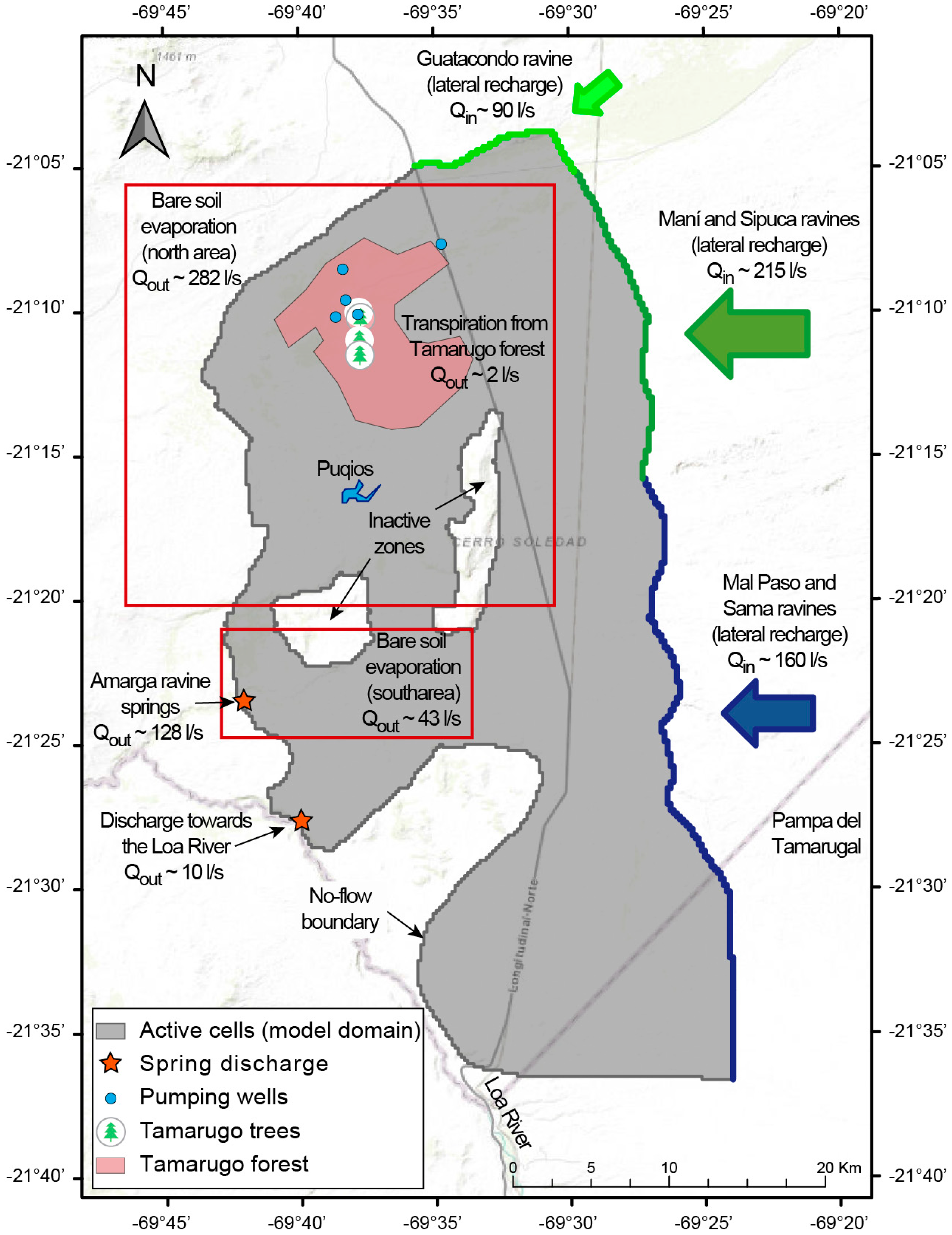
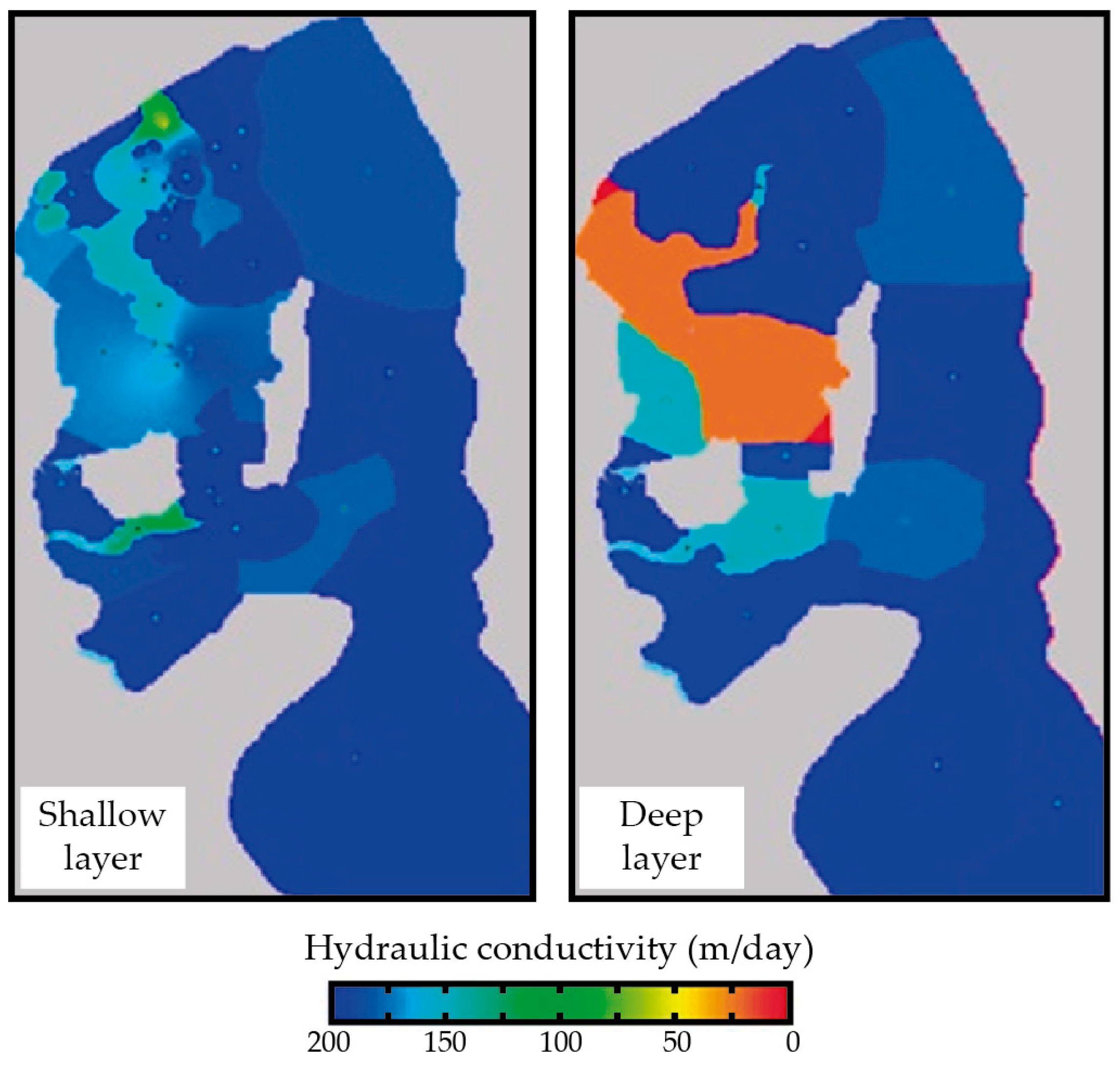
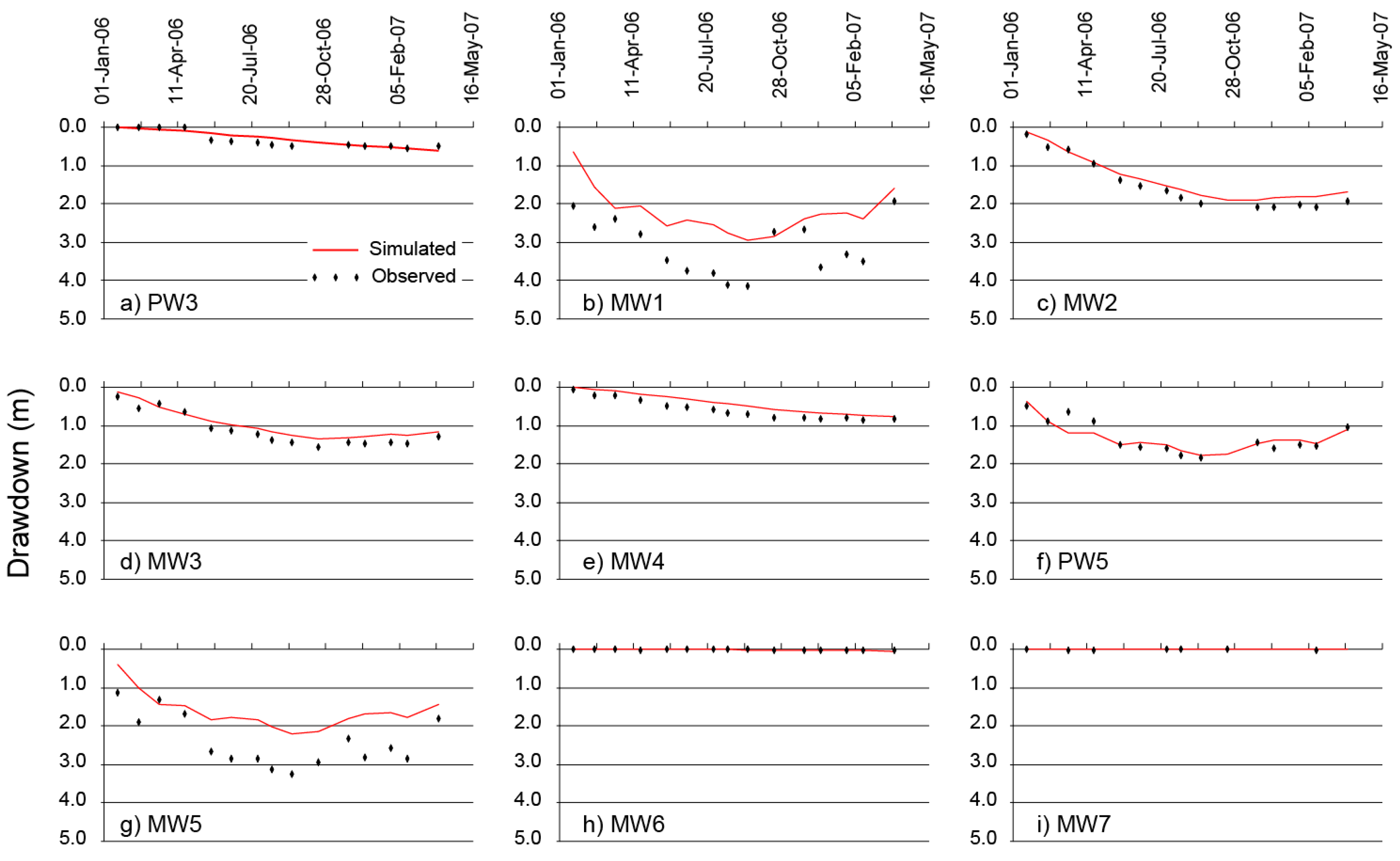

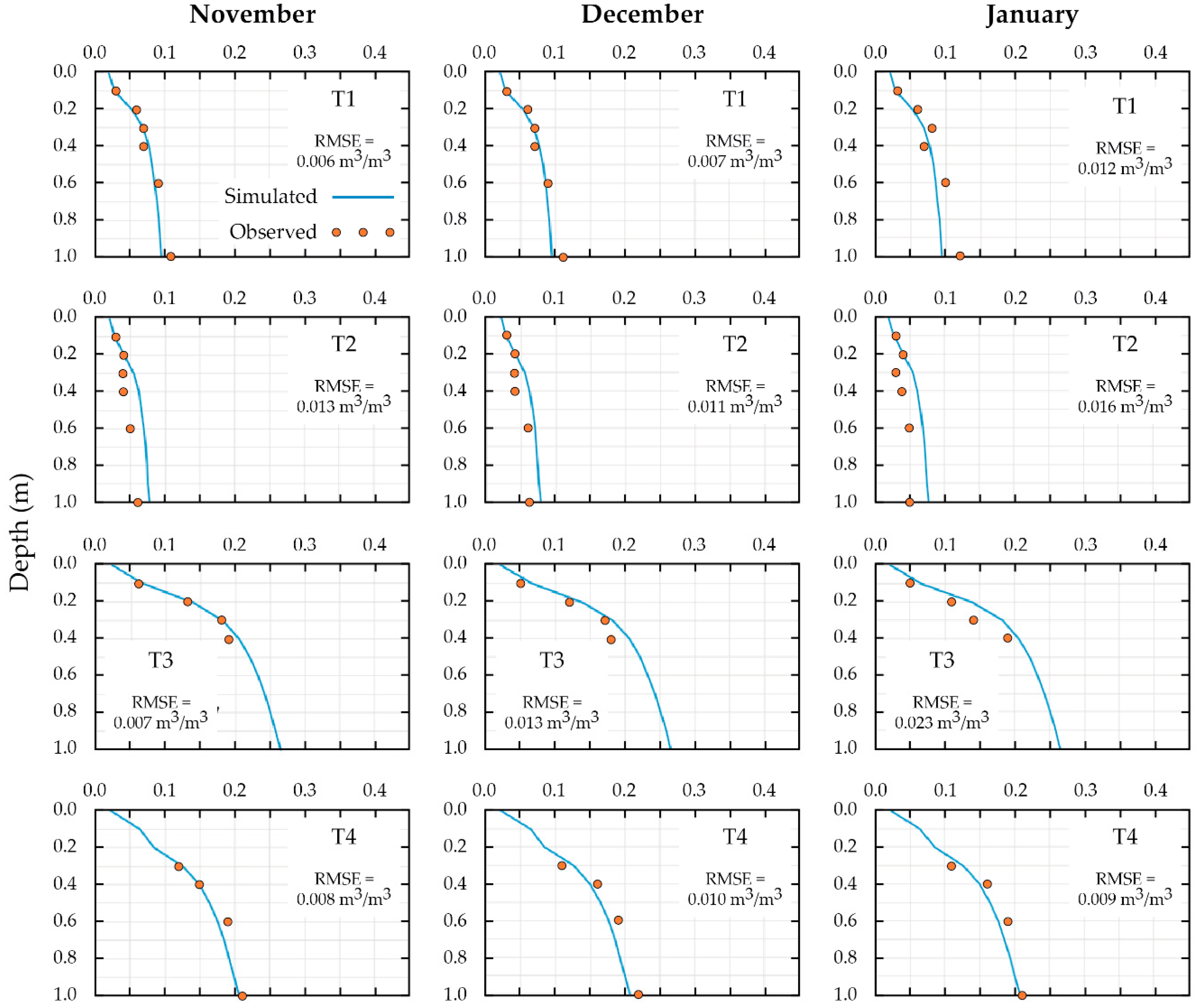
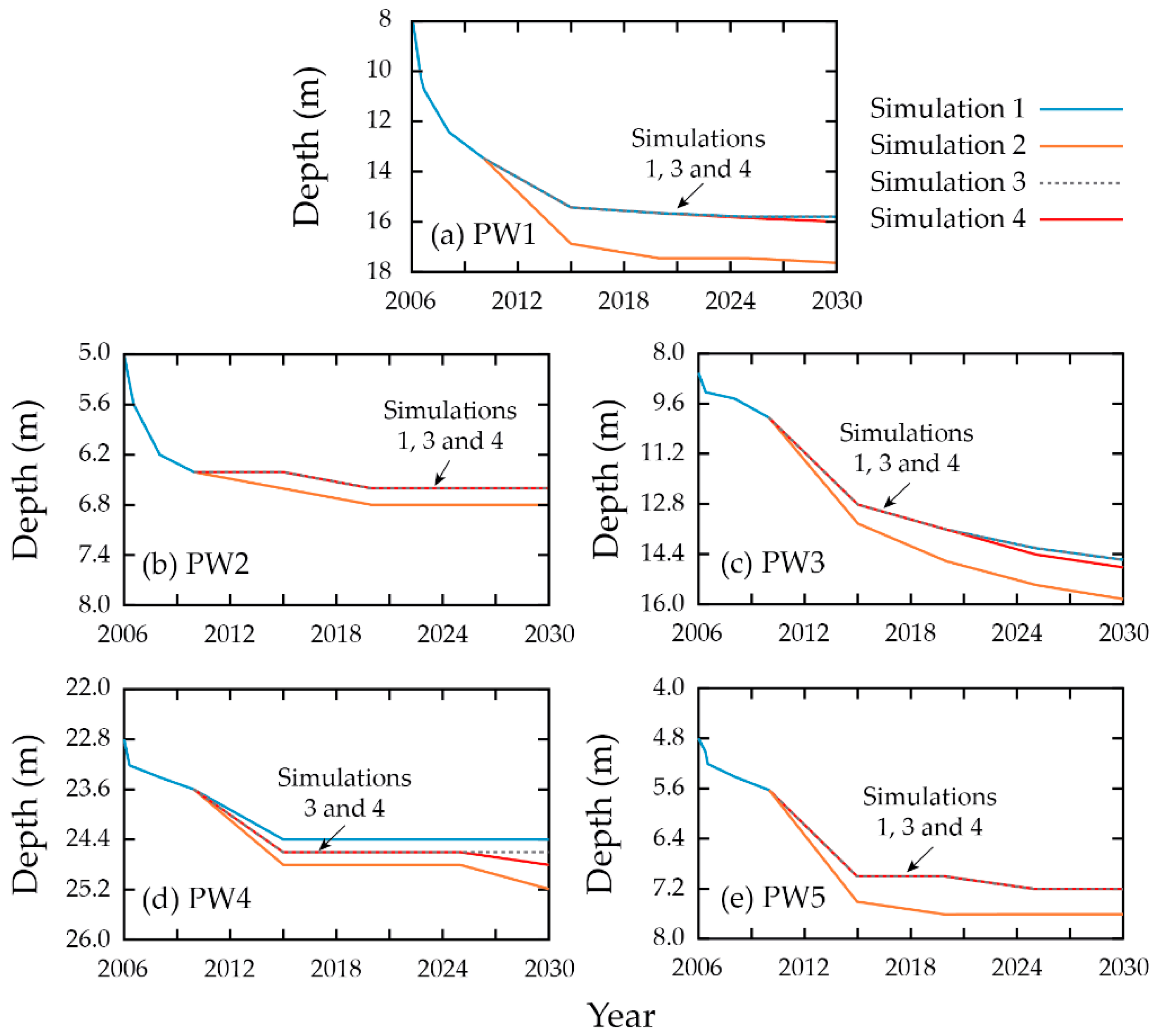
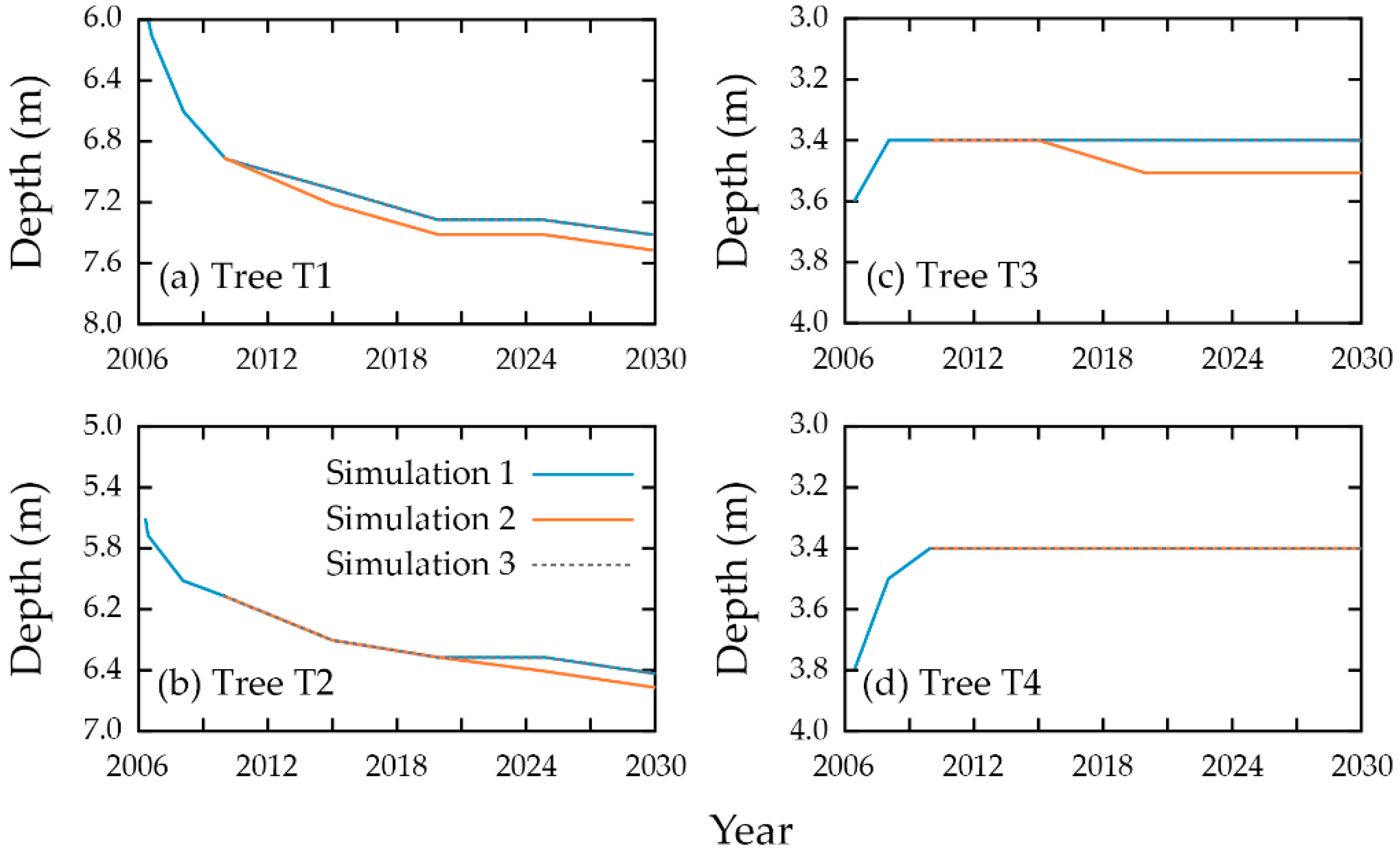
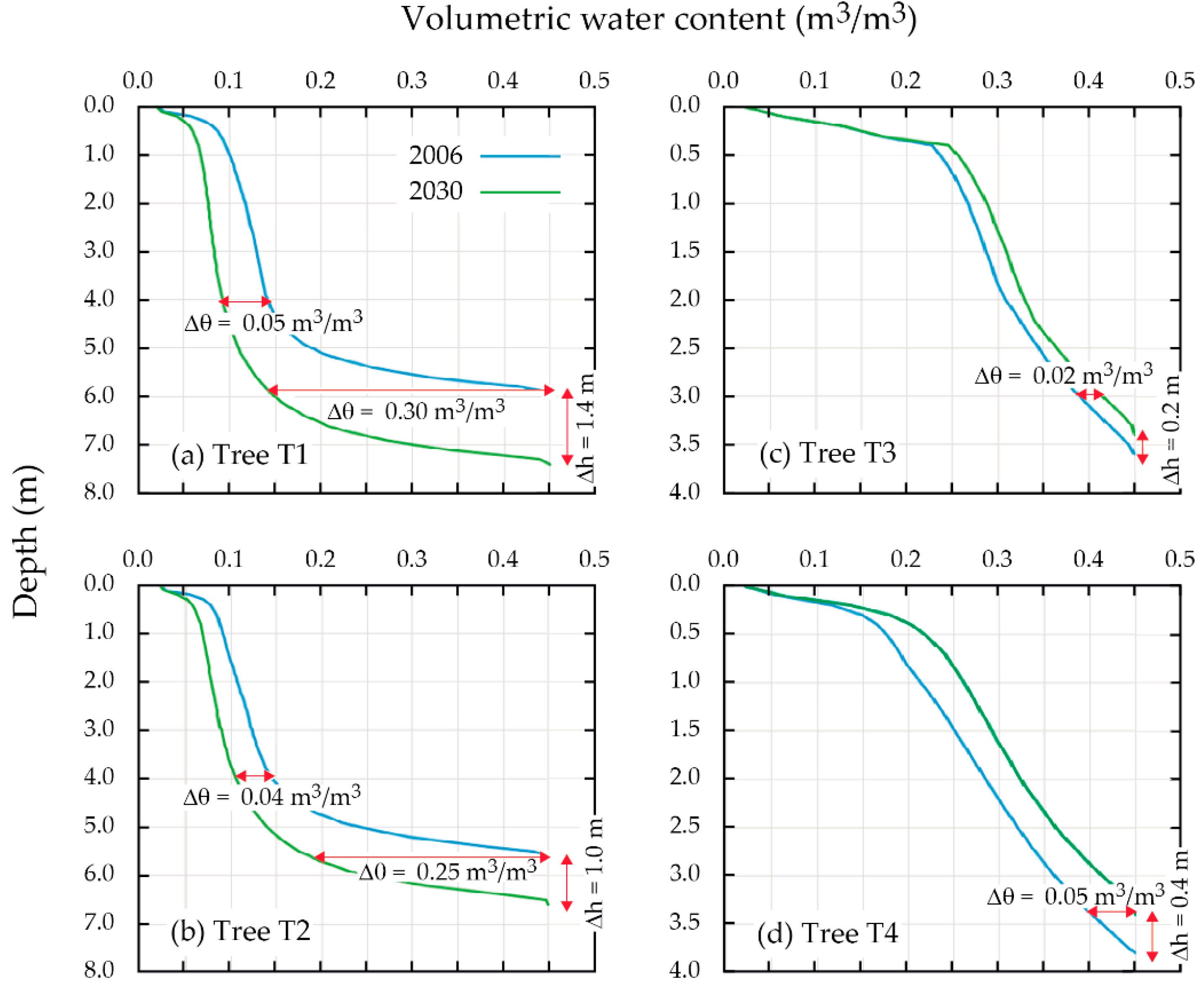
| Pumping Well | Simulation 1 (Baseline) | Simulation 2 (25% Increase in Withdrawal) | Simulation 3 (20% Decrease in Withdrawal) | Simulation 4 (Recharge Maintained) |
|---|---|---|---|---|
| PW1 | 60 | 75 | 60 | 60 |
| PW2 | 65 | 81 | 65 | 65 |
| PW3 | 35 | 44 | 35 | 35 |
| PW4 | 30 | 38 | 30 | 30 |
| PW5 | 31 | 39 | 31 | 31 |
| Total | 221 | 277 | 221 | 221 |
| Groundwater recharge | 465 | 465 | 372 | 80 |
| Parameter | Description | Value | Units |
|---|---|---|---|
| θr | Residual volumetric water content | 0.02 | m3/m3 |
| θs | Saturated volumetric water content | 0.45 | m3/m3 |
| α | Inverse of the bubbling pressure | 3.70 | m−1 |
| n | Empirical parameter | 1.68 | - |
| m | Empirical parameter | 0.40 | - |
| Location | Distance to PW1 (km) | Drawdown (m) 6 Months 1 | Drawdown (m) Year 2010 | Drawdown (m) Year 2030 |
|---|---|---|---|---|
| PW1 2 | 0.0 | 2.2 | 5.4 | 7.8 |
| T1 3 | 1.1 | 0.1 | 0.9 | 1.4 |
| T2 3 | 1.5 | 0.0 | 0.5 | 1.0 |
| T3 3 | 2.7 | 0.0 | −0.1 | −0.1 |
| T4 3 | 3.6 | 0.0 | −0.3 | −0.3 |
© 2019 by the authors. Licensee MDPI, Basel, Switzerland. This article is an open access article distributed under the terms and conditions of the Creative Commons Attribution (CC BY) license (http://creativecommons.org/licenses/by/4.0/).
Share and Cite
Samuel, A.; Blin, N.; Muñoz, J.F.; Suárez, F. An Unsaturated/Saturated Coupled Hydrogeological Model for the Llamara Salt Flat, Chile, to Investigate Prosopis tamarugo Survival. Geosciences 2020, 10, 1. https://doi.org/10.3390/geosciences10010001
Samuel A, Blin N, Muñoz JF, Suárez F. An Unsaturated/Saturated Coupled Hydrogeological Model for the Llamara Salt Flat, Chile, to Investigate Prosopis tamarugo Survival. Geosciences. 2020; 10(1):1. https://doi.org/10.3390/geosciences10010001
Chicago/Turabian StyleSamuel, Alex, Nicole Blin, José F. Muñoz, and Francisco Suárez. 2020. "An Unsaturated/Saturated Coupled Hydrogeological Model for the Llamara Salt Flat, Chile, to Investigate Prosopis tamarugo Survival" Geosciences 10, no. 1: 1. https://doi.org/10.3390/geosciences10010001
APA StyleSamuel, A., Blin, N., Muñoz, J. F., & Suárez, F. (2020). An Unsaturated/Saturated Coupled Hydrogeological Model for the Llamara Salt Flat, Chile, to Investigate Prosopis tamarugo Survival. Geosciences, 10(1), 1. https://doi.org/10.3390/geosciences10010001





